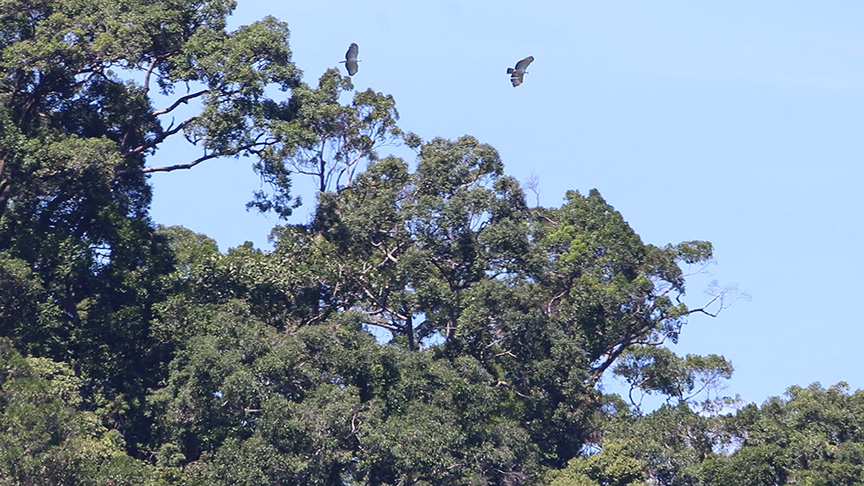ZAMBOANGA CITY (MindaNews / 03 July) — The forests in this city’s famed Pasonanca Natural Park and in other parts of the Zamboanga Peninsula are home to the Philippine Eagle (Pithecophaga jefferyi), the country’s national bird, officials of the Department of Environment and Natural Resources (DENR) said.
Aside from Pasonanca, the raptor “breeds in the wilderness, in the hinterlands of Baliguian, Zamboanga del Norte, in Midsalip, Zamboanga del Sur,” said Forester Arleigh Adorable, former regional executive director of DENR Region 9, and now of DENR Region 10.
 A pair of Philippine Eagles hovers above Pasonanca Natural Park in Zamboanga City. Photo courtesy of Jayson Ibanez of the Philippine Eagle Foundation
A pair of Philippine Eagles hovers above Pasonanca Natural Park in Zamboanga City. Photo courtesy of Jayson Ibanez of the Philippine Eagle Foundation
“The Philippine Eagle is the flagship species in the ecosystem of the Zamboanga Peninsula, as they dwell in the undisturbed primary forests of this southwestern Philippine region,” he emphasized.
Before the Davao City-based Philippine Eagle Foundation (PEF) sent a team to observe Pasonanca in 2019 for a research project, Philippine Eagles were sighted across the years hovering over the dense forest of the park along the upper Muruk area.
“The PEF is our partner in terms of protecting and conserving our national bird, the Philippine Eagle. Their aim in protecting the existence of this noble bird is laudable considering their employment of technology and research to better understand the wildlife,” said Pagadian City-based Roservirico Tan, regional public affairs officer of DENR-9 in a phone interview.
Jayson Ibañez, PEF research and conservation director Jayson Ibañez in a separate interview with MindaNews said, “We’re very lucky to have been working with the DENR-9 team since 2007, exploring eagles at Pasonanca (Natural Park) in Zamboanga City and Zamboanga del Norte.”
“Our collaboration resulted to the monitoring of a nesting eagle pair in 2007 at Baliguian (Zamboanga del Norte) then the pair nest again in 2009, 2011 and 2013. Then in 2013, we again collaborated to study an (Philippine) Eagle pair in Midsalip, Zamboanga del Sur,” Ibañez said.
However, the DENR regional office was under-equipped and undermanned in its documentation of birds, especially raptors. Moreover, the region’s Eagle Watch team members were transferred to the Provincial Environment and Natural Resources Office in Ipil, Zamboanga Sibugay as environment specialists and focused for a time on the water birds in Siay town.
In another phone interview, dela Cruz shared that documenting raptors requires cameras that are more advanced than the point-and-shoot kind and entry-level DSLRs. Cameras without a decent amount of optical zoom or powerful zoom lens would not enable the bird photographers to stalk the Philippine Eagles in the wild. DENR-9 has such equipment but the only person trained for it, Leo Alejo, is assigned in Ipil, and as a member of the Eagle Watch Team, he has to cross from Zamboanga del Norte to Zamboanga del Sur.
“It was in 2017 when the DENR-9 really invested in a very good camera equipment to record birds and other natural resources in the region,” dela Cruz, now technical services division chief of DENR-9- PENRO-Sibugay, said.
“The Philippine Eagle builds its nest on a huge pile of sticks, tediously and carefully placed high on her nest on a very tall tree and lays a single egg every two years,” said Gina Fernandez, environment specialist and former lead member of the region’s Eagle Watch team.
“Mike (dela Cruz) has been monitoring for seven years in Pasonanca (Natural Park), when he was PASU (Protected Area Superintendent). He was patrolling, gathering data and feather samples. He has been noting the Philippine Eagle to have left traces of feathers from 2005 to 2015, but could never find their nests during those years,” Fernandez, presently the Zamboanga Sibugay-PENRO Supervising Ecosystems and Management Specialist, said.
Through the years, the Regional Eagle Watch Team-9 documented following Philippine Eagles: Luyag in 1971; Zambo in 1981; Kalinawan in R. T. Lim, Zamboanga Sibugay; Marikit, retrieved in Liloy, Zamboanga del Norte (ZDN); Khing-Khing, retrieved in Dipolog City in 2006; Milla and Dionisio as a breeding pair in Linay , Baliguian, ZDN; Fernando as the first nesting record in 2007 also in Baliguian, ZDN; Binoni Pusaka (whose name in Subanon means ‘hidden treasure’) in Midsalip, Zamboanga del Sur in 2009;
Sibuco, which was retrieved in 2010 at the boundary of Pasonanca Natural Park and Sitio Lantawan, Tangarak, Sibuco, ZDN; Mitigam (‘clever’) recorded in 2011 in Baliguian, ZDN; Atbalin, documented in 2013 also in Baliguian; Dyan, documented in 2013 in Dakayakan, Midsalip; Jimrics, which has been documented starting when it was still an eaglet) in Dakayakan, Midsalip; Siocon, which was turned over in April 2020 from Bulacan, Siocon, ZDN; and the pair being monitored in Pasonanca.
“Kami po sa (We in) DENR Region 9 ay nagpapaalala (are reminding) to keep our wildlife in the wild. Ang (The) Philippine Eagle ay napakacrucial sa pagbalanse ng ating (is crucial to maintaining the balance of our) ecosystem. It helps naturally regulate species population, and it also gives protection sa ating ibang (to other) life forms sa kanyang teritoryo (in its territory). Help us preserve and protect our Philippine icon, our Philippine Eagle,” DENR Regional Executive Director Crisanta Marlene Rodriguez said.
The project involved the Protected Area Management Board, PEF, Zamboanga City Water District (ZCWD), City Government of Zamboanga and the United States Agency for International Development.
The biologists from PEF were Tristan Senarillos, Ron Taraya and Kemuel Libre, while the field technicians were Perfecto Balicao, who climbed the trees and stood as platform carpenter, Anecito Allado and Algen Agua, who served as the eagle spotters.
“Another unsung hero of the survey is Engr. Sonny Braulio of the Zamboanga City Water District. He was also the driving force for ZCWD participation and support to the project, even when we started the field reconnaissance in 2007 across different sites in Pasonanca,” Ibañez said.
“USAID funded the whole project, with some of their technical staff joining a few expeditions,” Dr. Ibañez concluded. (Frencie Carreon/MindaNews)
